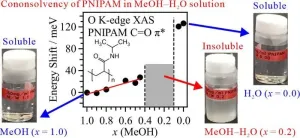(Press-News.org) Bethesda, MD (May 17, 2024) — The American Gastroenterological Association’s (AGA) new evidence-based Clinical Practice Guideline on Endoscopic Eradication Therapy of Barrett's Esophagus and Related Neoplasia, published today in Gastroenterology, establishes updated guidance for Barrett’s esophagus patients.
A precursor to esophageal cancer, Barrett’s esophagus is a condition in which the cells in the esophagus have been replaced with non-cancerous abnormal cells. These cells can progress to a condition called dysplasia, which may in turn become cancer. Dysplasia is considered low-grade or high-grade, depending on the degree of cellular change.
“While the benefit is clear for patients with high-grade dysplasia, we suggest considering endoscopic eradication therapy for patients with low-grade dysplasia after clearly discussing the risks and benefits of endoscopic therapy,” said guideline author Dr. Tarek Sawas, assistant professor in the department of internal medicine at UT Southwestern. “A patient-centered approach ensures that treatment decision is made collaboratively, taking into account both the medical evidence and the patient’s preferences and values. Surveillance is a reasonable option for patients who place a higher value on harms and a lower value on the uncertain benefits regarding reduction of esophageal cancer mortality”
Endoscopic eradication therapy consists of minimally invasive procedures such as endoscopic mucosal resection (EMR) or endoscopic submucosal dissection (ESD), followed by ablation (burning or freezing) techniques.
Key guideline takeaways:
For patients with low-grade dysplasia, it may be appropriate to either remove or monitor the cells. This is a decision doctors and patients should make together after discussing the risks and benefits of treatment.
For patients with high-grade dysplasia, AGA recommends endoscopic therapy to remove the abnormal pre-cancerous cells.
Most patients undergoing endoscopic eradication can be safely treated with EMR, which has a lower risk of adverse events. Patients who undergo ESD can face an increased risk of strictures and perforation. AGA recommends reserving ESD primarily for lesions suspected of harboring cancers invading more deeply into the wall of the esophagus or those who have failed EMR.
Patients with Barrett’s esophagus (dysplasia or early cancer) should be treated and monitored by expert endoscopists and pathologists who have experience in Barrett’s neoplasia.
“We need to have a conversation with patients in clinic prior to when they show up in the endoscopy unit on a gurney. Patients need to be fully aware of the risks and benefits, both in the short term but also in the long run, to decide which treatment approach is best for them. This decision often comes down to personal factors and values,” added guideline author Dr. Joel Rubenstein who is the director of the Barrett's Esophagus Program at the University of Michigan.
The guideline provides the following general implementation considerations:
Tobacco use and obesity are risk factors for esophageal adenocarcinoma, so counseling patients to abstain from tobacco use and to lose weight can help improve outcomes.
In patients with Barrett’s esophagus, reflux control should be optimized with both medication and lifestyle modifications.
Check out AGA’s GI Patient Center resources:
What is Barrett’s esophagus?
What is an upper GI endoscopy?
Guideline resources
Guideline: https://www.gastrojournal.org/article/S0016-5085(24)00302-0/fulltext
Clinical decision support tool: https://www.gastrojournal.org/article/S0016-5085(24)00432-3/fulltext
Spotlight (infographic): https://www.gastrojournal.org/article/S0016-5085(24)00433-5/fulltext
# # #
Media contact: Mara Shapiro, media@gastro.org
About the AGA Institute
The American Gastroenterological Association is the trusted voice of the GI community. Founded in 1897, the AGA has grown to more than 16,000 members from around the globe who are involved in all aspects of the science, practice and advancement of gastroenterology. The AGA Institute administers the practice, research and educational programs of the organization. www.gastro.org.
About Gastroenterology
Gastroenterology is the most prominent journal in the field of gastrointestinal disease. As the official journal of the AGA Institute, Gastroenterology delivers up-to-date and authoritative coverage of both basic and clinical gastroenterology. Regular features include articles by leading authorities and reports on the latest treatments for diseases. Original research is organized by clinical and basic-translational content, as well as by alimentary tract, liver, pancreas, and biliary content. www.gastrojournal.org/
AGA is now on Instagram.
Like AGA and Gastroenterology on Facebook.
Follow us on Twitter @AmerGastroAssn and @AGA_Gastro.
Check out our videos on YouTube.
Follow AGA on LinkedIn.
END
New guideline: Barrett’s esophagus can precede esophageal cancer, but not all patients need a procedure to remove abnormal cells
Experts call for an individualized approach to endoscopic eradication therapy.
2024-05-17
ELSE PRESS RELEASES FROM THIS DATE:
Researchers in Portugal develop an image analysis AI platform to boost worldwide research
2024-05-17
A team of researchers from the Instituto Gulbenkian de Ciência (IGC) in Portugal, together with Åbo Akademi University in Finland, the AI4Life consortium, and other collaborators, have developed an innovative open-source platform called DL4MicEverywhere published today in the journal Nature Methods*. This platform provides life scientists with easy access to advanced artificial intelligence (AI) for the analysis of microscopy images. Itenables other researchers, ...
A devastating fire 2,200 years ago preserved a moment of life and war in Iron Age Spain — right down to a single gold earring
2024-05-17
A ruined building in the middle of the Pyrenees records a tragedy for the people who lived there — a devastating fire which burned a settlement to the ground, destroying everything down to a hidden gold earring. Now archaeologists’ excavation of Building G, in the strategically placed Iron Age site of Tossal de Baltarga, reveals a way of life derailed by violence: potentially, a forgotten episode of the war between Carthage and Rome.
“The destruction was dated around the end of the third century BCE, the moment where the Pyrenees were involved in the Second Punic War and the passage of Hannibal’s troops,” ...
Exploration of polymer cononsolvency mechanism through soft X-ray absorption spectroscopy
2024-05-17
This study investigates the cononsolvency mechanism of poly(N-isopropylacrylamide) (PNIPAM), which is soluble in pure methanol (MeOH) and water but insoluble in aqueous MeOH solutions. Combining oxygen K-edge X-ray absorption spectroscopy (XAS) with theoretical calculations executed in molecular dynamics (MD) simulations and inner-shell calculations, it was found that hydrophobic interactions between PNIPAM and MeOH clusters play a key role in PNIPAM aggregation and cononsolvency emergence.
PNIPAM is ...
Researchers use machine-learning modeling tools to improve zinc-finger nuclease editing technology
2024-05-17
Genome editing is making inroads into biomedical research and medicine. By employing biomolecule modeling tools, a Japanese research team is accelerating the pace and cutting the cost of zinc finger nuclease (ZFN) technology, a primary gene editing tool.
In a recently published study, researchers from Hiroshima University and the Japanese National Institute of Advanced Industrial Science and Technology demonstrated how machine learning-driven modular assembly systems can improve gene editing.
The study was published on April 10 in the journal Advanced Science.
“Genome editing is ...
USC researcher awarded $3.1 million to study early brain development of babies born to mothers with diabetes in pregnancy
2024-05-17
It has long been understood that pregnant women with diabetes are more likely to have children with obesity than women who do not have diabetes during pregnancy. But scientists have not fully understood the cause or why babies born to mothers with diabetes are also more likely to develop obesity and associated metabolic disorders later in life.
To help find answers, Keck School of Medicine of USC researcher Shan Luo, PhD, has been awarded $3.1 million in funding from the National Institutes of Health and the National Institute of Diabetes ...
Men at greater risk of major health effects of diabetes than women
2024-05-17
Men are at greater risk than women of the major health effects of diabetes (types 1 and 2), suggests a long term study published online in the Journal of Epidemiology & Community Health.
Rates of cardiovascular disease, leg, foot, and kidney complications, and the sight-threatening eye disease diabetic retinopathy are all higher in men, regardless of whether they had diabetes for more or less than 10 years, the findings show.
The global prevalence of diabetes is similar in men and women, and is projected to rise to 783 million by 2045, note the researchers.
But ...
Likelihood of kids and young people smoking and vaping linked to social media use
2024-05-17
The more time spent on social media, the greater the likelihood that children and young people will both smoke and/or vape, suggests research published online in the respiratory journal Thorax.
Clocking up a weekday tally of 7 or more hours was associated with a more than a doubling in risk among 10 to 25 year olds, the findings indicate, reinforcing concerns about the marketing clout of these platforms, say the researchers.
The existing body of research on social media use and smoking and ...
Global life expectancy to increase by nearly 5 years by 2050 despite geopolitical, metabolic, and environmental threats, reports new global study
2024-05-17
**Embargo: 23.30 [UK time], 6:30 p.m. [EDT] May 16, 2024**
Global Burden of Disease
The latest findings from the Global Burden of Disease Study (GBD) 2021, published today in The Lancet, forecast that global life expectancy will increase by 4.9 years in males and 4.2 years in females between 2022 and 2050.
Increases are expected to be largest in countries where life expectancy is lower, contributing to a convergence of increased life expectancy across geographies. The trend is largely driven by public health measures that ...
High primary health coverage significantly reduces child mortality in Latin America
2024-05-17
The implementation of primary health care (PHC) over the last two decades has prevented more than 300,000 child deaths in four Latin American countries, and could prevent more than 140,000 by 2030 in a scenario of economic crisis. This is the main conclusion of a study coordinated by the Barcelona Institute for Global Health (ISGlobal), a centre supported by “la Caixa” Foundation, published in The Lancet Global Health.
The 2018 Astana Declaration highlighted the critical role of PHC in ensuring that everyone enjoys the highest possible standard of health, and in achieving universal health coverage. The Declaration also stressed the ...
Ubiquitin trailblazer elected Fellow of prestigious Royal Society
2024-05-17
WEHI division head and pioneer of ubiquitination Professor David Komander has been elected a Fellow of the esteemed Royal Society, the UK’s national science academy.
Prof Komander was recognised for his significant research contributions towards understanding ubiquitin, the ‘kiss of death’ protein which tells our cells which proteins to break down or recycle – a vital process that helps cells stay healthy and function correctly. Prof Komander’s work has helped unravel the ‘ubiquitin code’ that enables ubiquitin to perform many ...
LAST 30 PRESS RELEASES:
Pioneering natural, degradable polymer capsules
Forestry is becoming digital and automated
Maternity baby deaths much higher in northern England than in the South
Mosquitoes’ thirst for human blood has increased as biodiversity loss worsens
The stop-smoking medication varenicline may also work for cannabis use disorder
Potential new treatment for sepsis
Study reveals how many hours of video games per week might be too many
Electrospinning for mimicking bioelectric microenvironment in tissue regeneration
Home fingertip oxygen monitors less accurate for people with darker skin tones
Six weeks in a cast no less effective than surgery for unstable ankle fractures
Precautionary approach to alcohol-free and low alcohol drinks needed to protect public health, say experts
Gas-atomized Ca–Mg alloy powders produce hydrogen simply by adding water — high-efficiency hydrogen generation at room temperature
British redcoat’s lost memoir reveals harsh realities of life as a disabled veteran
World-leading rare earth magnet recycling facility launches in UK
Corday Selden selected for the Oceanography Society Early Career Award
MIT chemists determine the structure of the fuzzy coat that surrounds Tau proteins
Same moves, different terrain: How bacteria navigate complex environments without changing their playbook
Severe weather is deadly for vulnerable older adults long after the storm ends, study finds
Expert panel highlights opportunities for improving cancer studies
Hearing aid prescriptions not associated with changes in memory and thinking
Seth Zippel selected for The Oceanography Society Early Career Award
Jeremy Horowitz selected for The Oceanography Society Early Career Award
Kennesaw State University’s Jerry Mack named Paul “Bear” Bryant Newcomer Coach of the Year
Ancient teeth are treasure troves of data on Iron Age lifestyles
Avocados may become easier to grow in India—but not if global emissions remain high
Pregnant women with IBD show heightened inflammation in vaginal mucosa
Underwater photos show seabirds, seals and fish interacting with a tidal turbine in Washington State
1 in 5 surveyed UK adults who have experienced the death of a pet report it as more distressing than experienced human deaths, with significant rates of prolonged grief disorder symptoms also being re
Polyester microfibers in soil negatively impact the development of cherry tomato plants in experiments, raising concerns over the potential effect of high levels of such contaminants
LGBTQ+ adults may be around twice as likely to be unemployed or to report workforce non-participation compared to heterosexual adults, per large representative Australian survey
[Press-News.org] New guideline: Barrett’s esophagus can precede esophageal cancer, but not all patients need a procedure to remove abnormal cellsExperts call for an individualized approach to endoscopic eradication therapy.




